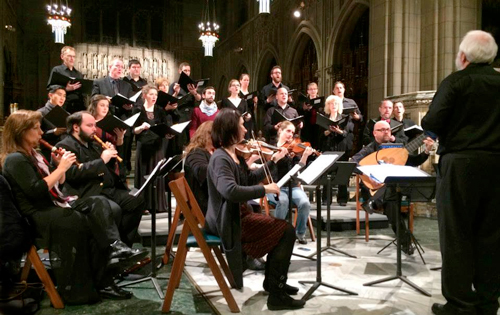by Nicholas Jones

Expanding an old pattern popular in the Renaissance, when masses were often constructed around a single hidden song-tune, Charpentier wrote his mass to incorporate not one but eleven Christmas songs. And while he followed the old polyphonic structures, in which a tune can easily get buried beneath the complex imitations among the voices, he made no effort to disguise these well-known “noëls.” The result is an elegant and “folksy” accompaniment to a midnight mass on Christmas Eve, appropriate to a night when, perhaps, not every Parisian was fully sober or intensely devout.
As Quire Cleveland music director Ross Duffin wrote in his notes, it must have been like listening to a Kyrie based on “We Three Kings.” The problem is, we don’t know these old French tunes. So Duffin decided to arrange them for unaccompanied chorus, and to have Quire sing them in alternation with the mass movements that draw on them — three folksongs, then the Kyrie which uses those three; two more, and then the Gloria; and so on.
Wisely trimming the noëls — some apparently have dozens of verses — Quire gave lively performances of these sweet tunes. The words were in French, but translations were supplied in the program, and a QR code (one of those scannable symbols that look like a game of dominos) took those of us with smartphones to the French texts. The choir’s old French was admirable, especially considering how much text they needed to deliver!
The songs have little to do with theological matters; they narrate everyday concerns about the Christmas story. What did the shepherds do when they saw the baby Jesus? Dance a courante, of course! What should a French farmer bring to the manger? A good soup with plenty of parsnips! How did Joseph feel about Mary’s pregnancy? “He was not a happy husband!”
The wit and tenderness of these popular tunes gives to Charpentier’s mass a different character from the generally serious mass settings we know from, say, Palestrina or Byrd. In Charpentier’s hands, nothing seems weighty: the mass text moves swiftly, and the polyphony is transparent. Charpentier’s mass is so dedicated to the simple pleasures of its “folk” origins that it has few of the soul-searching moments of other mass settings. Even the Crucifixus, the darkest point of most Credos, is jaunty and dancelike.
An excellent group of local period-instrumentalists accompanied the Charpentier, with an energetic and supple continuo — René Schiffer, cello and Simon Martyn-Ellis, theorbo (the long-necked member of the lute family) — and upper ensemble — Julie Andrijeski and Allison Monroe, violins, and Karina Schmitz, viola — with two wind players, Kathie Lynne Stewart and Luke Conklin, deftly alternating between baroque flute and recorder. Harpsichordist Peter Bennett unfortunately missed Friday’s concert at Trinity due to illness.
The choir and instrumentalists were well balanced and for the most part rhythmically in sync, though there were a few shaky passages. Solos, duets, and trios gave a number of individual singers a chance to shine. Overall, the choir sang with fine intonation and an appropriately French grace.
The idea of pairing the noëls with Charpentier’s mass was a bold experiment, giving the piece more of its historical and musical context than would be apparent without performing the original songs. But the folk songs were quite long and, though the French words were often charming in translation, they didn’t make enough of a varied impact to keep my interest.
The program ended with a beautiful arrangement of Jean-Philippe Rameau’s well-known “O Nuit!” The music was originally part of his opera Hyppolyte et Aricie, and later given new words that link it to the midnight setting of the Nativity story. As arranged by Duffin, it was a beautiful and moving end to the program. A brief encore gave us another French carol and its English equivalent, “Angels we have heard on high.” The audience joined in gratefully on the chorus, “Gloria in excelsis deo.”
Published on ClevelandClassical.com December 22, 2014.
Click here for a printable copy of this article



